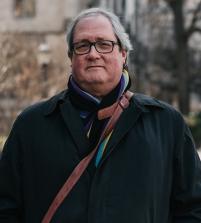
Redefining Redlining on Chicago’s Southside
The tulips in Amanda Williams' art installation enact for residents who live in or pass through the area that tenacious double effect of urban redlining: the mark of the past is never entirely erased.
This spring the artist/activist and MacArthur grant recipient Amanda Williams organized and implemented the planting of 100,000 tulips on vacant lots at 53rd St. and Prairie Avenue here on the south side of Chicago. You can learn about the project and view local coverage of it at redefiningredlining.com. In brief: Williams planted the tulips to mark the now vacant spaces once occupied by residential buildings that were redlined out of the neighborhood. In an ironic twist, she put her own contemporary red line of emphasis under the process by which the city of Chicago deemed parts of its neighborhoods hazardous and not “landworthy.”
This decidedly uncivil practice, begun in the 1930s and in this specific form extending at least into the 1990s, made it extremely difficult for Black people to build equity in that most American manner—through the acquisition and cultivation of real estate. Practices like redlining have done much to spur our city’s and our nation’s oligarchical economy.
What the philosopher Paul Ricoeur would describe as Williams’ “hermeneutics of suspicion” is accompanied by her “hermeneutics of retrieval”: in less highfalutin’ language, she planted not only a critique of past practice but a signal of hope for the future. Enabling her double move is her flower of choice: the tulip.
Williams selected the tulip to invoke the remarkable moment in early seventeenth-century Holland when economic speculation for tulips commanded more monetary value than everything, including real estate. It was a moment, however brief, when beauty and brute economic reality merged. Tulip stock soon fell, but it remains a moment to remind all of us that economic speculation is often a function less of the common good than of particular preference.
In addition to the historical reference, Williams is keenly aware that tulips bloom chiefly in spring and do not last the summer. While there is some debate about whether they are perennials or annuals, their lifespan is indubitably short. So it proved to be with this year’s planting at 53rd and Prairie, which produced a spectacularly shimmering miasma of red in the Grey City that within a few weeks relinquished almost all its luster.
The brilliance of Williams’ choice of tulips in relation to redlining is precisely in that cycle of invocation and disappearance. It enacts for residents who live in or pass through the area that tenacious double effect of urban redlining: the mark of the past is never entirely erased. We will not forget the impression made by the tulips, just as we must not forget the apartment buildings and small businesses that once decorated this particular postage stamp of southside Chicago. The tulips spur memory precisely to avoid forgetfulness.
Williams’ artistry is informed by the idea that “it’s the artist who foretells the revolution.” This particular project is one of a number of such efforts that she has undertaken toward its realization through the coordination of space, architecture, and color. In addition to its extraordinarily apposite invocation of urban memory and forgetting, I could not help but notice an unarticulated theological dimension to this particular project that makes it all the more resonant.
Students of the history of Christian theology will for better and for worse know the association of the “T.U.L.I.P.” formula with the theology of John Calvin and his followers. Especially but not only in American contexts, where acronyms are an especially favored form of systematic learning, “T.U.L.I.P.” is invoked as an aid to remember what are taken to be the foundational tenets of Calvinist theology: Total Depravity, Unconditional Election, Limited Atonement, Irresistible Grace, and Perseverance of the Saints. In the history of Reformed theology, the acronym is associated with the Synod of Dort (1618–19) at which Calvinists responded to the theological challenges of their antagonist Jacob Arminius. Dort was an important chapter in what came to be known as the tradition of Reformed theology and is exemplary of the widely shared dictum of the Reformation that the church should be semper reformanda (“always reforming”).
I see no signs that Amanda Williams is a Reformed theologian on such terms, although one could do worse than the phrase “perseverance of the saints” to describe the historical experience of Black people residing on Chicago’s southside. That noted, I would submit that to be “always reforming” is closely akin to “redefining redlining.” Amanda Williams is a lifelong resident of the southside who through her art visualizes for all who would see a sustained, racist practice of decisively malign consequence that many would prefer to put behind them or forget. The tulips signal for us the folly of that preference: to forget is to forget the joys and heartbreaks of people for whom those buildings were hearth and home.
As noted above, tulips enjoy a short life span during which they make an indelible mark in mind and memory. In this combination they present their caretakers with a dilemma: will they rise again the next year of their own accord? Or will another planting be required to bring them back in their brief but unmistakable glory? Williams’ floral installation, her outdoor exhibition, leaves southside Chicagoans with this exceptionally pertinent query, which has all too often gone ignored or unanswered in the past. Next spring will present an opportunity to notice and to answer.
Image by Irina Iriser via Unsplash


